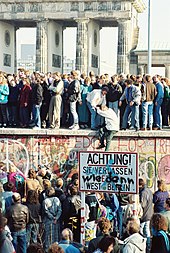
Back التحول في نظام الحكم بألمانيا Arabic Венденска революция Bulgarian Die Wende Catalan Die Wende Czech Die Wende Danish Wende und friedliche Revolution in der DDR German Turniĝo (politike) Esperanto Die Wende Spanish Die Wende French Die Wende Italian

Peaceful Revolution (German: Friedliche Revolution) was the process of sociopolitical change that led to the opening of East Germany's borders to the Western world as part of the Revolutions of 1989. The peaceful revolution marks the end of the ruling by the Socialist Unity Party of Germany (SED) in the German Democratic Republic (GDR or "East Germany") in 1989 and the transition to a parliamentary system. This peaceful transition later enabled the German reunification in October 1990. The peaceful revolution was marked by non-violent initiatives and demonstrations. This period of change is referred to in German as Die Wende (German pronunciation: [diː ˈvɛndə], "the turning point").
These events were closely linked to Soviet leader Mikhail Gorbachev's decision to abandon the Soviet sphere of influence. In addition to the Soviet Union's shift in foreign policy, the GDR's lack of competitiveness in the global market economy, as well as its sharply rising national debt, hastened the destabilization of the SED's one-party state.
© MMXXIII Rich X Search. We shall prevail. All rights reserved. Rich X Search